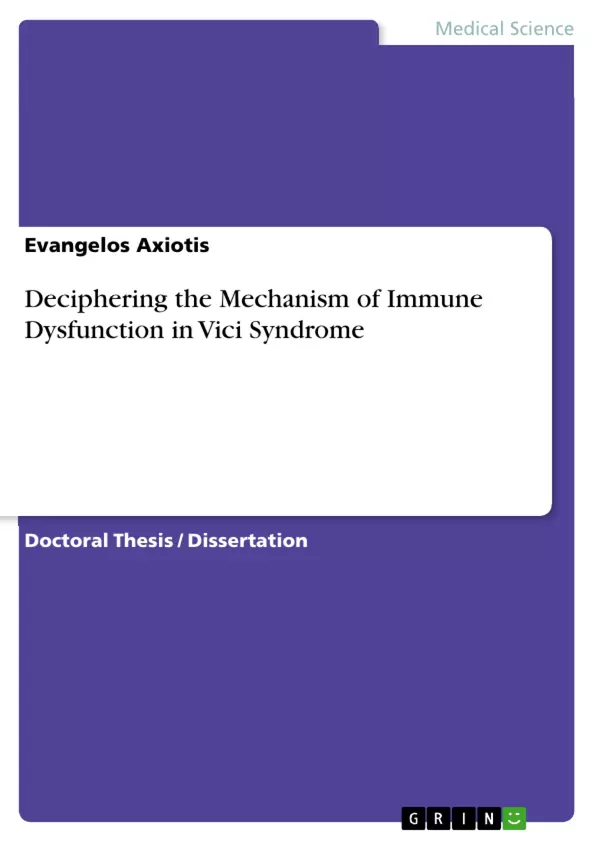Vici syndrome is a complex multisystem disorder characterized by congenital malformations of the brain, cataracts, skin hypopigmentation, progressive damage of cardiac function and muscle, immune deficiency. Affected children do not respond to vaccination, have low levels of antibodies in the blood and suffering from severe and frequent infections. The disease is caused by a mutation of the gene EPG5, which encodes a protein essential for the trafficking and function of intracellular vesicles.
Cells use vesicles to eliminate uwanted material and remove dead cells. The unwanted material is incorporated into a vesicle and then merged with lysosomes containing proteins that digest the contents to be eliminated (autophagy).
This system is essential already during the embryonic stage and then for life. Therefore, its failure causes a disease involving various organs and systems. Since infections are frequent in patients with Vici Syndrome, we think that EPG5 plays a role in the immune system:
In this project i propose to assess whether EPG5 is necessary for cells to capture and degrade microorganisms and foreign particles, a necessary step to start the immune reaction. To do this i use cells from patients and healthy controls with fluorescent molecules to study the formation and trafficking of vesicles and evaluate the activation of immune cells by measuring the levels of antibodies and cytokines.
Other metabolic diseases and multisystem syndromes, often also associated with immunodeficiency, are in fact caused by genes involved in trafficking, merge or release of vesicles in the cell. My study is a prototype, intended to clarify the underlying mechanisms of a defect in a specific immune complex disease. The results will be used to develop therapies appropriate to fight at least in part the symptoms and risks in patients with multisystem genetic disease.
Inhaltsverzeichnis (Table of Contents)
- Chapter 1 - INTRODUCTION.
- 1.1) Vici Syndrome
- 1.2) EPG5
- 1.3) Autophagy and endocytosis
- 1.4) Pathogenesis of Vici Syndrome
- 1.5) Toll-like protein receptors (TLRs)
- Chapter 2 - AIM OF THE WORK..
- Chapter 3 - MATERIALS AND METHODS..
- 3.1) Materials
- 3.1.1) Patients clinical data
- 3.1.2) Cell Cultures
- 3.2) Methods
- 3.2.1) Isolation of Peripheral Blood Mononuclear Cells (PBMCs)
- 3.2.2) Generation of a lymphoblastoid cell lines
- 3.2.3) PBMCs stimulation with TLR2-9 agonists
- 3.2.4) Fibroblast stimulation with CpG or IL-1ẞ and NF-kBp65 translocation
- 3.2.5) CpG-FITC internalization in lymphoblastoid cell lines (LCLs)
- 3.2.6) Immunofluorescence
- 3.2.7) Transient gene silencing by siRNA
- 3.2.8) Transient gene transfection by lipofection
- 3.2.9) Transient gene transfection by electroporation
- 3.2.10) Extraction of genomic DNA
- 3.2.11) Extraction and quantification of the RNA
- 3.2.12) Reverse transcription and amplification (RT-PCR)
- 3.2.13) Electrophoresis, extraction from the agarose gel and sequencing of PCR products
- 3.2.14) Amplification and quantification by real-time PCR
- 3.2.15) Protein extraction and quantification
- 3.2.16) Electrophoresis of proteins by SDS-polyacrylamide gel
- 33.2.17) Western blotting
- 3.2.18) Plasmid constructs and transformation of bacterial cells
- 3.2.19) Preparation of plasmid DNA
- 3.2.20) DQ-BSA internalization
- 3.1) Materials
- Chapter 4-RESULTS.
- 4.1) Molecular genetic analysis
- 4.2) Analysis of the effects of mutations on the transcribed EPG5
- 4.3) Analysis of the effects of the mutations on protein EPG5
- 4.4) Stimulation of PBMC in vitro with TLR2-9 agonists
- 4.5) Detection of NF-kB p65
- 4.6) Analysis of intracellular transport of DQ-BSA
- 4.7) Analysis of intracellular transport of CpG (EAA1, LAMP1, LAMP2)
- 4.8) Internalization of CpG-FITC in the patient's and control fibroblasts
- 4.9) Transient silencing of EPG5 and internalization of CpG-FITC
- 4.10) Cellular localization of EPG5 in HEK293T cell lines
- Chapter 5-DISCUSSION.
Zielsetzung und Themenschwerpunkte (Objectives and Key Themes)
This Ph.D. thesis aims to investigate the mechanisms of immune dysfunction in Vici syndrome, a rare genetic disorder characterized by severe immune deficiency, developmental delay, and neurological abnormalities. The study focuses on the role of the EPG5 gene, which encodes a protein involved in autophagy and endocytosis, in the pathogenesis of the disease.
- The role of EPG5 in immune function and its association with Vici syndrome.
- The impact of EPG5 mutations on autophagy and endocytosis pathways.
- The effects of EPG5 dysfunction on TLR signaling and immune responses.
- The potential therapeutic implications of understanding the molecular mechanisms of Vici syndrome.
Zusammenfassung der Kapitel (Chapter Summaries)
- Chapter 1: Introduction provides an overview of Vici syndrome, including its clinical presentation, genetic basis, and pathogenesis. This chapter also delves into the roles of EPG5, autophagy, endocytosis, and TLRs in the context of the disease.
- Chapter 2: Aim of the Work outlines the specific objectives and research questions addressed in the study.
- Chapter 3: Materials and Methods details the experimental design, including the patient cohort, cell lines, and techniques employed to investigate EPG5 function and its role in immune dysfunction.
- Chapter 4: Results presents the findings of the study, covering molecular genetic analysis, the impact of EPG5 mutations on protein function, and the effects of EPG5 dysfunction on immune responses.
Schlüsselwörter (Keywords)
Vici syndrome, EPG5, autophagy, endocytosis, TLR signaling, immune dysfunction, genetic disorder, rare diseases, molecular mechanisms, therapeutic implications.
- Quote paper
- Evangelos Axiotis (Author), 2015, Deciphering the Mechanism of Immune Dysfunction in Vici Syndrome, Munich, GRIN Verlag, https://www.grin.com/document/295415



